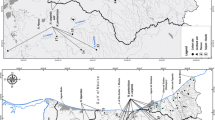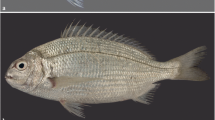Abstract
The endemic Persian Gulf herring, Herklotsichthys lossei, has similar characteristics with other congeners, especially H. punctatus, which makes it difficult to recognize. Freshly collected samples from the type locality of H. lossei assign morphologically to H. lossei, described by Wongratana in having a dark blotch on the dorsal fin and small dark spots on the flank. However, all the studied materials have a series of black spots along the back and both sides of dorsal–fin base which was not mentioned by Wongratana and was not found in the examined type materials deposited in Natural History Museum, London. Based on the available molecular data (mtCOI) for six species of Herklotsichthys, it is clear that the genus is not monophyletic. Herklotsichthys dispilonotus, H. punctatus and H. lossei make a sister lineage to other congeneric species including H. quadrimaculatus, H. lippa and H. spilurus and also with several phylogenetically distantly related genera Sardinella, Harengula, Amblygaster, Nematalosa, Anodontostoma, Alosa, Clupea and Clupeonella. This situation makes the taxonomic status of clupeid genera, especially Herklotsichthys more complicated. As H. dispilonotus the type species of the genus Herklotsichthys is nested with H. lossei and H. punctaus, these three species remain in the same genus and three others, H. quadrimaculatus, H. lippa and H. spilurus form a distinct genera.




Similar content being viewed by others
REFERENCES
Baldwin, W., Mounts, J., Smith, D., and Weigt, L., Genetic identification and color descriptions of early life–history stages of Belizean Phaeoptyx and Astrapogon (Teleostei: Apogonidae) with Comments on identification of adult Phaeoptyx,Zootaxa, 2008, pp. 1–22. https://doi.org/10.11646/zootaxa.3133.1.1
Bloom, D. and Lovejoy, N., The evolutionary origins of diadromy inferred from a time-calibrated phylogeny for Clupeiformes (herring and allies), Proc. Biol. Sci., 2014, vol. 281. https://doi.org/10.1098/rspb.2013.2081
Bruford, M., Hanotte, O., Brookfield, J., and Bruke, T., Single-locus and multilocus DNA fingerprinting, in Molecular Genetic Analysis of Population, Hoelzel, A.R., Ed., Oxford: Oxford Univ. Press, 1992, pp. 225–269.
Fischer, W. and Bianchi, G., FAO Species Identification Sheets for Fishery Purposes Western Indian Ocean (Fishing Area 51), Rome: FAO Fish. Dep., 1984. http://www.fao.org/3/ad468e/ad468e00.htm.
Fricke, R., Eschmeyer, W.N., and Fong, J., Catalog of fishes: species by family/subfamily, version 05/2019, 2019. http://archive.calacademy.org/research/ichthyology/catalog/Species.
Hall, T., BioEdit: a user–friendly biological sequence alignment editor and analysis program for Windows 95/98/NT, Nucleic Acids Symp. Ser., 1999, vol. 41, pp. 95–98.
Higgins, D. and Sharp, P., CLUSTAL: a package for performing multiple sequence alignment on a microcomputer, Gene, 1988, vol. 73, pp. 237–244. https://doi.org/10.1016/0378-1119(88)90330-7
Kapli, P., Lutteropp, S, Zhang, J., Kobert, K., Pavlidis, P., Stamatakis, A., and Flouri, T., Multi-rate Poisson tree processes for single–locus species delimitation under maximum likelihood and Markov chain Monte Carlo, Bioinformatics, 2017, vol. 33, no 11, pp. 1630–1638. https://doi.org/10.1093/bioinformatics/btx025
Keskin, E. and Atar, H., DNA barcoding commercially important fish species of Turkey, Mol. Ecol. Resour., 2013, vol. 13, no 5, pp. 788–797. https://doi.org/10.1111/1755-0998.12120
Lavoue, S., Miya, M., Musikasinthorn, P., Chen, W., and Nishida, M., Mitogenomic evidence for an Indo-West Pacific origin of the Clupeoidei (Teleostei: Clupeiformes), PLoS One, 2013, vol. 8, no 2, art. ID e56485. https://doi.org/10.1371/journal.pone.0056485
Lavoue, S., Konstantinidis, P., and Chen, W., Progress in Clupeiform Systematics, in Biology and Ecology of Sardines and Anchovies, Ganias, K., Ed., Boca Raton, FL: CRC Press, 2014. https://doi.org/10.1201/b16682-3
Lavoue, S., Bertranda, J., Chena, W., Motomurae, H., Sadof, T., and Miya, M., Phylogenetic position of the rainbow sardine Dussumieria (Dussumieriidae) and its bearing on the early evolution of the Clupeoidei, Gene, 2017, vol. 623, pp. 41–47. https://doi.org/10.1016/j.gene.2017.04.032
Li, C. and Ortí, G., Molecular phylogeny of Clupeiformes (Actinopterygii) inferred from nuclear and mitochondrial DNA sequences, Mol. Phylogenet. Evol., 2007, vol. 44, pp. 386–398. https://doi.org/10.1016/j.ympev.2006.10.030
Losse, F., The Elopoid and Clupeoid Fishes of East Africa Coastal Waters, Rome: UN Food Agric. Org., 1968, pp. 77–115.
Mousavi-Sabet, H., Vatandoust, S., Geiger, M., and Freyhof, J., Paracobitis abrishamchiani, a new crested loach from the southern Caspian Sea basin (Teleostei: Nemacheilidae), Zootaxa, 2019, vol. 4545, no 3, pp. 375–388. https://doi.org/10.11646/zootaxa.4545.3.3
Nelson, J., Grande, T., and Wilson, M., Fishes of the World, New York: Wiley, 2016.
Owfi, F. A review on systematic and taxonomic of the Persian Gulf fish species based on geographical distribution pattern and habitat diversity, using by GIS, PhD Thesis, Tehran: Islamic Azad Univ., 2015.
Plough, L., Ogburn, M., Fitzgerald, C., Geranio, R., Marafino, G., and Richie, K. Environmental DNA analysis of river herring in Chesapeake Bay: a powerful tool for monitoring threatened keystone species, PLoS One, 2018, vol. 13, no 11, art. ID e0205578. https://doi.org/10.1371/journal.pone.0205578
Posada, D. and Crandall, K., Modeltest: testing the model of DNA substitution. Bioinformatics, 1998, vol. 14, no 9, pp. 817–818. https://doi.org/10.1093/bioinformatics/14.9.817
Price, A., Sheppard, C., and Roberts, C., The gulf: its biological setting, Mar. Pollut. Bull., 1993, vol. 27, pp. 9–15. https://doi.org/10.1016/0025-326x(93)90004-4
Randall, J., Coastal Fishes of Oman, Honolulu: Univ. of Hawaii Press, 1995.
Randall, J. and Di Battista, J., Etrumeus makiawa, a new species of round herring (Clupeidae: Dussumierinae) from the Hawaiian Islands, Pac. Sci., 2012, vol. 66., pp. 97–111. https://doi.org/10.2984/66.1.6
Ronquist, F. and Huelsenbeck, J.P., MrBayes 3: Bayesian phylogenetic inference under mixed models, Bioinformatics, 2003, vol. 19, pp. 1572–1574. https://doi.org/10.1093/bioinformatics/btg180
Sayyadzadeh, G., Teimori, A., and Esmaeili H.R., Paraschistura kermanensis, a new stone loach species from southeastern Iran (Teleostei: Nemacheilidae), Zootaxa, 2019, vol. 18, no 4638, no. 4, pp. 571–83. https://doi.org/10.11646/zootaxa.4638.4.7
Stamatakis, A., RAxML-VI-HPC: maximum likelihood-based phylogenetic analyses with thousands of taxa and mixed models, Bioinformatics, 2006, vol. 22, no. 21, pp. 2688–2690. https://doi.org/10.1093/bioinformatics/btl446
Tamura, K., Stecher, G., Peterson, D., Filipski, A., and Kumar, S., MEGA6: Molecular Evolutionary Genetics Analyses version 6.0, Mol. Biol. Evol., 2013, vol. 30, pp. 2725–2729. https://doi.org/10.1093/molbev/mst197
Whitehead, P., A contribution to the classification of clupeoid fishes, Ann. Mag. Nat. Hist., Ser. 12, 1963, vol. 5, pp. 737–750.
Whitehead, P., A review of the elopid and clupeid fishes of the Red Sea and adjacent regions, Bull. Br. Mus. (Nat. Hist.),Zool., 1965, vol. 12, no 7, pp. 225–281.
Wongratana, T., Diagnoses of 24 new species and proposal of a new name for a species of Indo-Pacific Clupeoid fishes, Jpn. J. Ichthyol., 1983, vol. 29, no 4, pp. 385–407.
Zhang, J., Kapli, P., Pavlidis, P., and Stamatakis, A., A general species delimitation method with applications to phylogenetic placements, Bioinformatics, 2013, vol. 29, no. 22, pp. 2869–2876. https://doi.org/10.1093/bioinformatics/btt499
ACKNOWLEDGMENTS
We thank Jame Maclaine, Senior Curator of Natural History Museum of London and Kevin Webb, photographer, for providing holotype and paratype photos of H. lossei, Reza Sadeghi (Shiraz University) and Vahid Mazarei (an engineer from MAPNA company), for helping in fish collecting. We are thankful to B.W. Coad (Canadian Museum of Nature) for editing the manuscript.
Funding
The research was funded by Shiraz University and was approved by the Ethics Committee of the Biology Department (SU–9430246).
Author information
Authors and Affiliations
Corresponding author
Ethics declarations
Conflict of interests. The authors declare that they have no conflict of interest.
Statement on the welfare of animals. All applicable international, national, and/or institutional guidelines for the care and use of animals were followed.
Rights and permissions
About this article
Cite this article
L. Purrafee Dizaj, Esmaeili, H.R., Valinassab, T. et al. Taxonomic Status and Molecular Systematics of an Endemic Fish, Herklotsichthys lossei (Clupeidae) from the Persian Gulf: Insights into Non-monophyly of the Genus. J. Ichthyol. 60, 375–386 (2020). https://doi.org/10.1134/S0032945220030066
Received:
Revised:
Accepted:
Published:
Issue Date:
DOI: https://doi.org/10.1134/S0032945220030066




